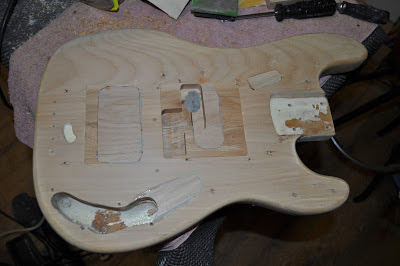SOLD!!
This Fender Precision was repaired and refinished and assembled from a bunch of vintage parts I collected over time. I had always wanted to build an Olympic White with Tortoise Guard P-bass, as I think the creamy color of the aged Olympic White looks great with the brownish-red of a vintage tortoise guard. So I assembled this example, but now have decided to part with it as I have more than half a dozen vintage Precisions and I really don't need that many.
The body is refinished with a '60s style nitro finish: yellow stain, clear sealer coat, flat white primer, Olympic White color coat and a tinted clear topcoat. The tinting of the clear coat was done such that there is a "shadow" under the pickguard, neckplate, bridge and bridge cover with those areas yellowed less than the exposed areas of the body (see below).
The resulting bass weighs in at almost exactly 8 lbs with the chromed bridge and pickup covers on. The 70s grey-bottom pickup (10.8K Ohm resistance) is powerful and sounds great (like they all do!) and the bass plays well. The neck has a tiny amount of relief ( 1/32nd of an inch) and plays well up and down the neck and intonates pretty accurately as currently set up.
The bass is not a mint-condition restoration, but is also priced accordingly at about half of what an original sunburst '72 P-bass sells for currently.
The bass comes in a kind of beat-up but solid early 70's Fender bass case with a fairly rare rootbeer colored lining - I originally got the case with a mutilated '73 Jazz bass that was brought to the US from London, so maybe its an export Fender case? It has the correct 1972 - 1975 Fender logo on it.
This bass is located in the Boston area and is available for in-person examination if you're local. For those outside of the Boston area, shipping will be extra - please contact me with your location and I will give you a quote for shipping via FedEx or USPS.
I accept payment by cashier's cheque/money order, cash in person or Paypal - though there will be an additional charge to cover Paypal expenses (approx. 3 1/2% of total).
Please direct all inquiries to me via email: krishna@guitargarage.net - with something like "'72 P-bass" in the subject line so I don't miss your email if it ends up in my spam folder.
Details
The majority of the parts ARE correct for a 1972 Fender Precision, but they are from different instruments originally.
The vintage parts include:
- 1972 B-width neck, refretted and refinished with repro logo
- 1970 - 1973 alder body, with routing repairs and refinished in aged Olympic White
- 1970s grey-bottom Fender P-bass pickup
- 1969 - 1972 Fender bridge with extended G saddle screw
- 1968 - 1975 Fender 4-ply tortoise guard, with chip at point near output jack
- 1972 - 1975 "F" tuners & bushings
- 1972 - 1973 Fender hardcase, with rootbeer-colored lining
The reproduction parts include:
- chrome bridge & pickup covers
- strap-buttons
- F-logo neckplate
- pots, knobs and output jack
- various screws
- thumbrest
- nut
Body repair and refinishing
The body is a vintage Fender body, from between late 1969 and early 1973, based on the following characteristics:
- two dowel-pin marks on back, one on the body centerline near the butt of the body and one just inside the bass side cutaway (P-bass bodies from late 1967 through about 1979)
- placement of the bridge closer to the edge of the body (1969 til late 72/early73)
- no channel routed from control cavity to pickup (1958 through early 1973)
- remnants of yellow stain, which would have been applied under the finish (approx 1960 - 1973)
Most likely this was originally a sunburst body, though its hard to tell with all the modifications and refinishes its had over the past 40 years.
The front of the body is where the real mayhem has occurred !! The body had been routed and plugged once before I even got it - for a large bridge pickup and a larger pickup in the stock middle position, as well as routing for a switch at the bass side of the pickguard and for an extra control/and or battery under the guard adjacent to the stock control cavity.
I plugged all the routed areas with alder - using epoxy as the adhesive to minimize shrinkage over the long term. I feel that using a glue with water content (such as Titebond or hide glue) will swell up the glued-in plugs - more so than the surrounding wood - but this swelling subsides VERY slowly - especially once the plugs are sealed up and finished over (on the order of 3 months to over a year). Using a two-part epoxy, there is little to no moisture introduced - and the epoxy itself has minimal shrinkage and is very tough/strong.
I then re-routed the pickup cavity and the edge of the control cavity - the results before finishing are visible below.
And here's the body with the flat white primer coat applied - ready for the color coats.
Once the color coats had been applied and wet sanded, then the entire body was clear-coated, with a VERY slight amber tinting to take some of the edge off the blinding whiteness. Note the back of the original tortoise guard - with some factory marks (9) and grounding foil applied.
At the correct angle, the outlines of the plugs for the bridge pickup and the switch near the pickguard edge are just visible - click on pictures for expanded views.
read more →












































